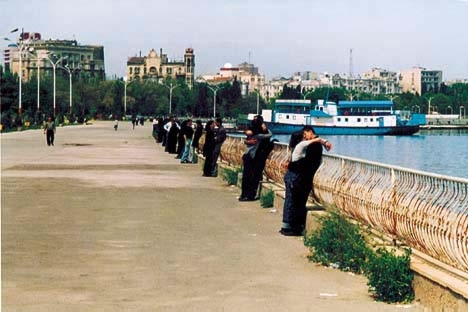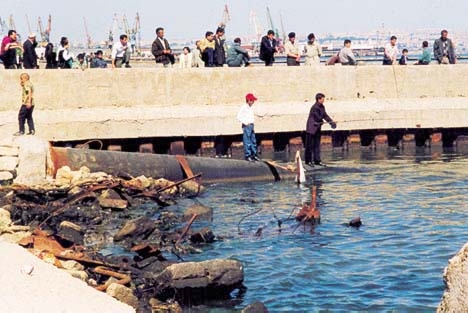|

Summer 2000 (8.2)
Pages
40-42
Beautifying
the Bay
New Environmental
Project Launched
by
Maarten A. Gischler

In the early part of the 20th century, waterfront activities
were the most common form of recreation in Baku. Azerbaijanis
enjoyed swimming, boating and sailing on the nearby Baku Bay.
However, when Baku citizens were recently surveyed about their
opinions on the Bay, few knew that it had once been a popular
recreation area.

Photo: Kodor, the old schooner
that once served as a restaurant, caught fire and sunk. Now plans
are being made to clear the sea of wreckage like this and other
boats.
When asked what the Bay might look like in 2020, residents had
trouble seeing beyond today's serious problems: the polluted
air, the smell of sewage, the sight of oil on the Caspian waves,
the debris and scrap material floating in the water. Few could
imagine swimming in the water once again, much less eating fish
caught fresh from the Bay.

Photo: Fishing of the Boulevard
in the polluted Caspian.
There is a long way to go before the Bay will be clean. The pollution
problems are as complex as the solutions, and the whole process
may take two or three decades. But Azerbaijanis are working to
make it happen, with help from their friends.
Tough Problems
Early in 1999, a team of experts from the State Committee for
the Environment, the Academy of Sciences, the Baku Municipality,
the Azerbaijan Marines, Kasmorniiproyekt, Kaspbasu and IWACO
(International Water Consultants) from the Netherlands started
making an inventory of the environmental problems and their underlying
causes. The list included:
1. Baku Bay presently
receives a surplus of around 400,000 square meters of sewage
each day because the city's network of municipal sewers and pumping
stations can convey only part of the wastewater to the main treatment
plant at Hovsan, which is 15 km outside of Baku. While the Berlin
Wasser Betrieb and the municipality have drafted plans to convey
more wastewater to the plant and expand its capacity, implementation
is still pending.
2. The oil refineries and the Bibi Heybat oil field discharge
thousands of tons of oil into the Bay each year because facilities
designed to separate the oil from the wastewater are obsolete
and non-functional. "Emergency" discharges into the
Bay when facilities break down are frequent.
3. Offshore oil wells -
abandoned after the Caspian Sea level rose nearly 3 meters between
1984 and 1995 - have not been plugged and may already have begun
to leak.
4. Over the past 20 years,
many studies have shown that the Bay's bottom sediment is contaminated
with 3 to 5 million tons of petroleum hydrocarbons. However,
the removal of this sediment makes no sense as long as the ongoing
sources of pollution have not been halted.
5. Many ships in the Bay
do not appear to use the Baku Port Authority's reception facilities
for wastewater and waste oil, and can be seen discharging directly
into the Caspian.
6. Roughly 50 shipwrecks,
a number of obsolete piers, various uncompleted structures, and
dozens of abandoned industrial scrap yards and dumpsites clog
the waterfront and need to be removed.
This list of
possible and necessary targets for action seems hopelessly long,
and the dream of a clean Baku Bay pales under the glaring light
of present-day environmental and economic realities. But all
hope is not lost. In Europe and the United States, similar inventories
drawn up 25 years ago produced to-do lists that were just as
long. In the last two decades, Western countries have made an
enormous amount of progress in environmental cleanup.
Action Plan
While environmental degradation of the Baku Bay has been going
on for much of the 20th century, it wasn't until 1998 that the
bay appeared on the list of Azerbaijan's priority environmental
problem areas, as part of the National Environmental Action Plan.
This, and the fact of the Bay's importance in the life and industry
of Baku, convinced the Netherlands' Government to fund the Baku
Bay Oil Pollution Project in cooperation with the Azerbaijan
State Committee for the Environment.
Azerbaijan Deputy Prime Minister Ali Hasanov, who heads the Steering
Committee for the Baku Bay project, communicated clearly from
the outset that he expected more than just "paper"
from the Azerbaijan State Committee for Environment and the Dutch
consultants of IWACO who implement the project. Rather, environmental
action was required.
Boulevard Project
As Baku's prime recreational spot and a newly proclaimed national
park, the Boulevard seemed like the logical place to start. While
funding was not available for the vast cleanup of oil or stoppage
of sewage outfalls, which will eventually take place, the pilot
project could remove those obsolete objects that had no place
in the first sketches of a master plan for the Baku Boulevard,
approved by President Heydar Aliyev in 1999.
Both SOCAR and the municipality agreed to support in the form
of equipment and labor, while IWACO agreed to fund operational
costs and initiate a fundraising campaign for public awareness
activities. Unocal-Khazar was the first to respond positively,
with BP Amoco, ExxonMobil and Pennzoil pitching in as well.
In February a group of environmental NGOs - Azerbaijan Green
Movement, Khazri Teta, Youth Environmental Center, Ecoscope,
Ecoyl Scientific Environmental Society and the Center for Research
of Environmental Problems - started making preparations for involving
the public, including leaflets and a poster campaign. One goal
of the project is to explain environmental issues to a wider
public and challenge citizens to think about complex problems
and the role they can play in resolving them.
By March the municipality began divers' inspections of an obsolete
pier along the boulevard, and at the end of April SOCAR removed
the first object, the Kodor, an old schooner that had served
as a restaurant until a fire sank it in August 1999. Also scheduled
to be removed are an estimated 75 to 100 tons of metal and concrete
waste that is sitting along the Boulevard, either in the water
or on piers.
On May 20, Caspian Day, 50 schoolchildren helped clean up the
litter in Baku Boulevard National Park. Street theater and art
contests were also organized. A video was presented on the Bay's
environment, and a two-week exhibition was mounted in a pavilion
on the waterfront, with help from the Nature Protection Society
and the TUTU Children's Cultural and Educational Center.
The Baku Boulevard Pilot Project has proven that all of the ingredients
needed to successfully clean up the Bay do exist and can be called
to action. Private industries, public organizations and government
offices must join together to restore Baku's Caspian waterfront.
If Baku institutions show genuine commitment, the international
community will be ready to assist and make its contribution,
and together Azerbaijanis can make their bay as healthy and beautiful
as it once was.
Maarten A. Gischler is a consultant in water and environment
for the Dutch firm IWACO, and is team leader of the Baku Bay
Oil Pollution Project, funded by the Netherlands' Ministry of
Economic Affairs. The Ministry signed its first memorandum of
understanding (MOU) with Azerbaijan in 1998 to provide support
and cooperate in the sectors of agriculture, energy and environment.
The MOU was renewed at the end of 1999, securing support until
at least 2001.
Dutch companies that are involved in Azerbaijan include Shell,
IWACO, NeSA, a subsidiary of RACAL, Dredging International, Tebodin
Consultants, AA Services, Construction, Cleaning and Waste Management
and ABNAMRO Bank.
From Azerbaijan
International
(8.2) Summer 2000.
© Azerbaijan International 2000. All rights reserved.
Back to Index
AI 8.2 (Summer 2000)
AI Home
| Magazine Choice | Topics
| Store
| Contact
us
|



